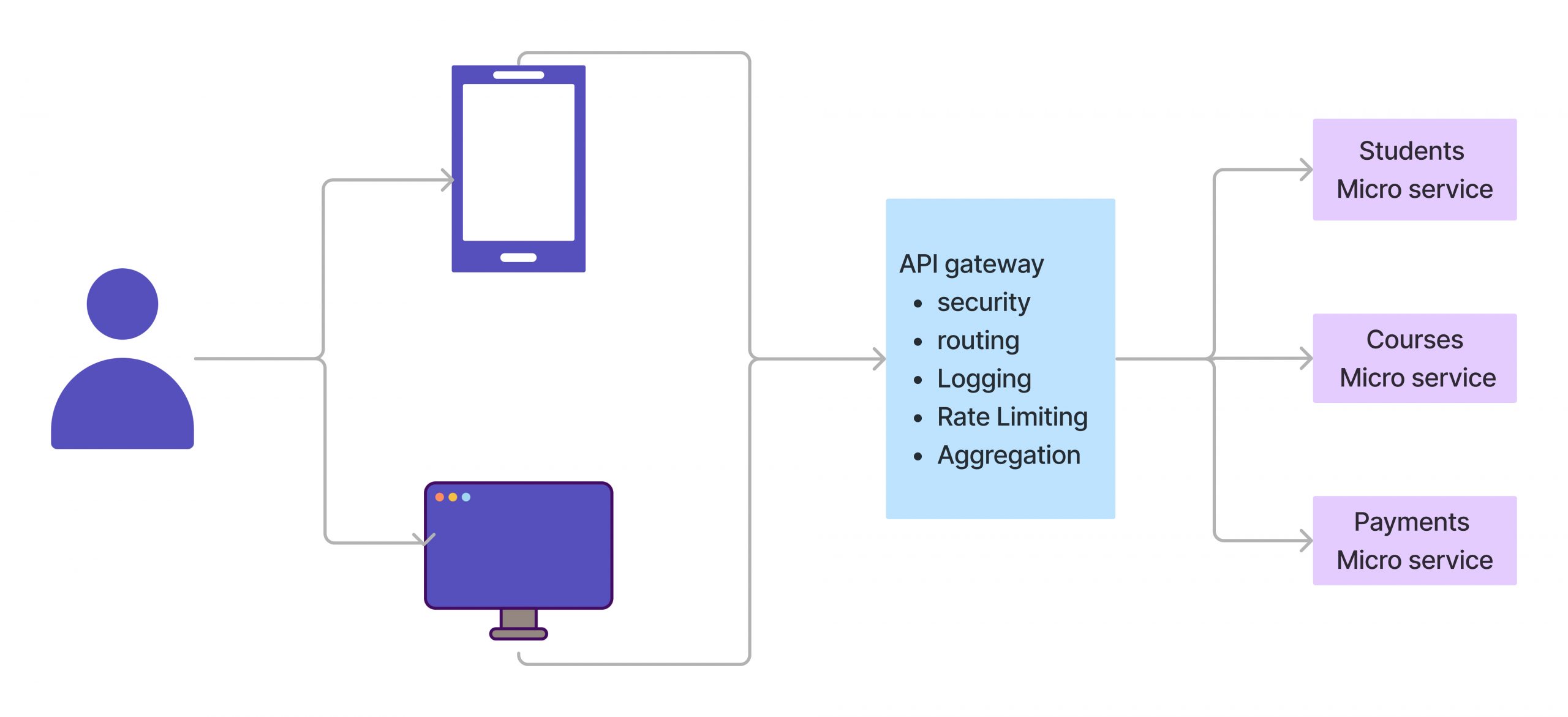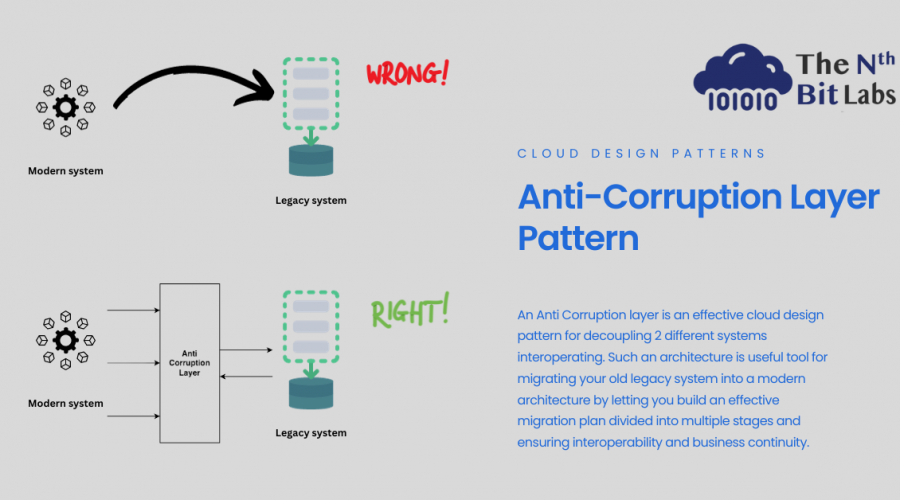API Gateways; it seems to have become a hot buzzword that often gets tossed around in discussions about building robust and scalable tech products. But you are not alone if you do not fully understand what it means, how it contributes to the strength and scalability of your B2B or B2C software product, and how you can actually benefit from it.
What is an API Gateway?
API gateway is a design pattern that works like a middleman between API endpoints and backend services. It receives the Client’s API requests, aggregates them, and then routes them to the required service endpoints. When a client initiates an API request, the API Gateway steps in, consolidating and managing these requests before efficiently directing them to the specific service endpoints they require.

To support the smooth transitioning from the legacy system to the modern system, your systems need to interoperate. Hence, maintaining access between new and legacy systems can force the new system to adhere to at least some of the legacy system’s APIs or other semantics. So the problem is the potential corruption of your modern clean architecture in order to support the legacy system/features. A similar problem arises when dealing with external 3rd party systems.
In short, the API Gateway acts as a vital link, optimizing the flow of data between clients and backend services, contributing to a more organized, responsive, and streamlined operation of digital systems.
Use Cases of API Gateways
Whether you are building a B2B or a B2C SaaS product, API Gateways can be the game-changer for your business. After reading the use cases of API gateway you’ll know how it enhances both the performance and security of your software.
1.Caching
API gateways store the data of request responses for reuse later. It not only enhances the performance of the server but also reduces the load on back-end services. If it receives similar requests earlier, it sends the response from the cache itself rather than back-end services. Imagine you have a favorite online game. Instead of fetching the latest game updates every time you play, the API gateway stores a copy (cache) of the updates. So, when you want to play again, it quickly gives you the stored updates, reducing the time and resources needed to fetch them anew.
2.Aggregation
Think of your phone displaying news from various sources in one app. An API gateway aggregates information from different sources and presents it in a unified way. It is a unified point for clients to access various service points. In this, one gateway receives and handles all the requests and routes them to its respective backend service. It’s like having one app that combines news, weather, and social media updates seamlessly.
3.Request Routing
In a system with multiple services, the gateway guides requests to the appropriate service, ensuring they reach the right destination efficiently. Let’s understand request routing with an example. Picture ordering food online. The API gateway directs your order request to the correct restaurant’s kitchen that you have actually ordered from.
4. Rate Limiting and Throttling
Rate limiting is a method that is used to limit the number of requests a user can make in a given period. While throttling refers to a technique that controls the load of traffic an API can handle and prevents overloading the server at once. Still confused? Let’s clear this up with an example.
Suppose you’re at an ‘All-You-Can-Eat’ buffet. To make sure everyone gets a fair share, the restaurant sets limits on how fast you can fill your plate. API gateways do something similar; they control the rate at which requests are made to prevent overload or abuse, ensuring fair access for everyone.
5. Authorization and Authentication
Just like you need a pass to enter the VIP lounge at an event, API gateways use authentication and authorization permission from the user to access the services. API gateways ensure that only authorized users (with proper access credentials) can use certain parts of a system, just like the VIP lounge is restricted to specific guests. When using methods like OAuth or JWT, the API Gateway may issue and validate tokens. These tokens carry information about the authenticated user and are used to grant access.
Common API Gateway Patterns
Choosing the right API gateway pattern is pivotal for designing a successful software product. Each pattern comes with distinct advantages, addressing specific needs within the system. Here are some API gateway patterns you should consider while designing your APIs.
Centralized Edge Gateway
A centralized edge gateway in API gateway patterns is a design where a single, centralized point manages and controls external API requests. This gateway acts as the entry point for all requests, providing a unified location for enforcing security measures, authentication, and access control.
The Centralized Edge Gateway ensures consistency and simplicity in managing client requests. It is an effective choice for businesses seeking centralized control over their API ecosystem while maintaining a secure and streamlined communication channel.
Two-tier Gateway
In API gateway design patterns, a two-tier gateway is a configuration where there are two distinct gateways involved in handling API requests. The first gateway, known as the client-facing gateway, is situated at the system’s edge and manages interactions with clients. Its primary role is to receive incoming requests and then forward them to the second gateway.
The second gateway, often referred to as the backend gateway, is responsible for further routing these requests to the appropriate backend services. The two-tier gateway design pattern is particularly useful when there’s a need to isolate the client-facing gateway from the backend gateway. This isolation can be motivated by security concerns or the desire to enhance scalability and manageability in large and complex systems. Overall, the two-tier gateway design pattern offers a flexible and organized way to handle API interactions in a distributed architecture.
Microgateway
A Microgateway in API gateway patterns is tailored for microservices architecture , providing individualized control over each service. It means every microservices has its own API gateway. Unlike a centralized gateway, the Microgateway allows for independent scaling and maintenance of microservices. This pattern ensures flexibility and agility in dynamic systems where services evolve independently. It optimizes communication efficiency, offering a decentralized approach to managing APIs.
The Microgateway pattern is particularly advantageous in environments where adaptability, scalability, and autonomy of microservices are crucial for maintaining a responsive and evolving system.
Per Pod Gateway
In the per-pod gateway pattern, the dedicated API gateway for each pod serves as an intermediary between the clients and the services running within the pod. This gateway acts as a reverse proxy, managing the routing of requests from clients to the appropriate services and forwarding the responses back to the clients.
The primary advantage of the per-pod gateway pattern is the level of isolation and autonomy it provides to each pod. By having a dedicated gateway for each pod, there is greater control over the pod’s own network traffic. This can be advantageous for security and scalability reasons, as different pods may have varying requirements that can be addressed by using distinct types of gateways or hardware configurations.
However, it’s important to note that implementing a per-pod gateway pattern can introduce increased complexity in management. Maintaining and managing separate gateways for each pod may require additional effort compared to other API gateway design patterns, and the decision to adopt this pattern should be based on careful consideration of the specific requirements and trade-offs within a given system.
Sidecar Gateways
A sidecar gateway in API gateway patterns is an architectural design where a separate, companion component (sidecar) is attached to each service. This companion, or sidecar, enhances the capabilities of the service without directly impacting its core functionality. Sidecar Gateways allow for the modular addition of features such as security, logging, or communication protocols to specific services, promoting a more granular and flexible approach to API management.
This pattern is advantageous when specialized functionalities need to be integrated seamlessly with individual services in a distributed system, providing enhanced versatility and maintainability.
Best practices for implementing the API gateway pattern
Implementing the API Gateway pattern is a strategic move that can significantly streamline your system architecture . To ensure a smooth and effective integration, consider the following best practices:
- Rate Limiting: Implement rate limiting to control the number of requests a client can make within a specific timeframe, preventing misuse and ensuring fair usage.
- Authentication: Prioritize robust authentication mechanisms to safeguard your API Gateway and the underlying microservices from unauthorized access. Utilize secure protocols like OAuth or API keys.
- Real-Time Monitoring: Establish real-time monitoring systems to keep a vigilant eye on the API Gateway’s performance. This ensures prompt identification of any anomalies or potential issues, allowing for swift resolution.
- Logging and Auditing: Maintain comprehensive logs and auditing processes to track API usage and identify potential security threats. This is crucial for post-incident analysis and continuous improvement.
- Caching Strategies: Employ efficient caching strategies to enhance performance and reduce latency, optimizing the overall response time for clients.
- Error Handling: Prioritize effective error handling by providing clear and informative responses. This aids developers in troubleshooting and improves the overall user experience
These are some of the best practices you can opt to ensure a secure, scalable, and efficient implementation of the API gateway pattern that fosters optimal communication between your microservices.
How Can We Help?
Need help with the deployment of API gateways for your digital products? Reach out to The Nth Bit Labs.
The Nth Bit Labs has perfected the art of API gateway patterns with Nginx . We have demonstrated an unparalleled proficiency in addressing the intricate challenges of API management. Our proficiency with Nginx has not just perfected patterns; it has laid the foundation for innovative solutions, allowing developers to navigate the complexities of distributed systems with confidence.






